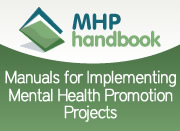Tools
- Utilities:
- Print this page
- Send this page
- Font size:
- Increase font size
- Decrease font size
Monitoring and Evaluating the Process
- Monitoring and Evaluating the Process
- Evaluating the Process
- Ensuring Continuous Progress
Aims
- To gather information that can be used to evaluate the MHP programme
- To monitor the progress of the health programme plan and adjust the plan accordingly
What Needs to be Done
At the beginning of the MHP programme, it is important to develop a monitoring protocol. This consists of stating what information will be collected, who will collect it and when it will be collected. It is too late to gather monitoring information after the programme has finished.
The kinds of information that may be of interest are:
- Process information – This refers to information about the process of implementation. It might include measures such as numbers participating in the programme, satisfaction with how the process was organised and so on.
- Output information – This refers to the immediate impact of the programme, and may include measures of participation individual activities, initial reactions to the programme and so on.
- Outcome information – this refers to the longer term impact that the programme has had on the target groups and the organisation as a whole. Measures of outcomes include health and wellbeing, organisational performance and so on
The monitoring protocol for the MHP project should contain the following kinds of information:
- The objectives of the programme (these should be stated in terms which makes them easy to measure)
- Specific targets of the programme (these are generally numerically stated objectives, e.g. numbers of participants, percentage improvement in health and wellbeing)
- The monitoring instruments to be used (e.g. interviews, focus groups, questionnaires)
- The schedule of and responsibilities for monitoring activities
The information collected for purposes of monitoring the programme may be either quantitative or qualitative. Quantitative information may be collected via such instruments as questionnaires or interviews and allows for easy numerical analysis of the information.
Qualitative information is usually collected via interviews or other face-to-face techniques (though questionnaires may also be used). This information It provides a richer picture of what has happened than quantitative information, but is more complex to analyse during the evaluation activity
Who is Involved?
The Project Manager and project participants



